Occupational Environment Monitoring at Electric Kettle Manufacturing Factory
99,000 ₫
Note: The above price is calculated for one sample, the price may vary depending on the area of the environment to be monitored and the fluctuations of the market. For more accurate price support, please refer to the quotation table or contact our consulting staff directly.
Environmental monitoring of the electric kettle manufacturing factory is a session of collecting, analyzing, and evaluating workplace factors that may harm workers’ health.
Table of Contents
Toggle1. Overview of Electric Kettle Manufacturing Factory
a. What is an electric kettle manufacturing factory?
Manufacturing factory for electric kettles is a production facility specialized in manufacturing kettles that can boil water quickly and efficiently. Electric kettles are commonly used in households, offices, hotels, and restaurants to quickly boil water for various purposes.

b. Production stages in the electric kettle manufacturing factory
The electric kettle manufacturing factory usually performs the following production stages:
- Material preparation: Processing and preparing necessary components and materials such as kettle body, heating element, control button, temperature controller, electric wires, water pipes, and other components.
- Assembly: Assembling the components according to the production process to form a complete kettle. This process includes connecting parts, installing the controller and safety system, and testing the kettle’s functionality.
- Quality inspection: Conducting quality checks to ensure that the kettle meets standards for safety, performance, and durability. Inspections may include voltage testing, boiling function, temperature safety, automatic shut-off, and other requirements.
- Packing and shipping: After quality inspection, the kettle is packed according to specifications to ensure safety during transportation and marketing. Kettles may be packed in cardboard boxes, labeled with serial numbers, and accompanied by user manuals.
- Distribution: Completed electric kettles are shipped to stores, dealers, or end customers.

c. Machinery used in electric kettle manufacturing factories
In the electric kettle manufacturing factory, various machines are used to carry out production and processing. Common machinery includes:
- Metal cutting machines: Used to cut and process metal components such as the kettle body, lid, and other parts.
- CNC lathes: Used to machine metal components to specific dimensions and shapes.
- Press machines: Used to press metal parts to form the kettle body and other components.
- Welding machines: Used to weld metal parts together, ensuring the kettle’s sturdiness and safety.
- Plastic injection machines: Used to mold plastic components such as the heating element housing, control buttons, and other plastic parts.
- Cutting, bending, and processing machines for small components: Used to cut, bend, and process small parts like wires, water pipes, and electronic components.
- Printing machines: Used to print logos, product information, and instructions on the kettle.
- Quality inspection machines: Used to check functionality, performance, and safety of kettles before packing and shipping.

d. Occupational diseases for workers in electric kettle factories
Workers in electric kettle factories may face the following occupational diseases:
- Respiratory diseases: Exposure to metal fumes, metal dust, or chemical vapors during processing and welding may cause respiratory irritation, pneumonia, or other respiratory issues.
- Peripheral and musculoskeletal disorders: Working with machinery and mechanical tools can lead to musculoskeletal injuries, back pain, cervical spine degeneration, and related problems.
- Skin diseases: Exposure to chemicals during production may cause skin irritation, dermatitis, allergies, and other skin problems.
- ENT (ear, nose, throat) issues: Exposure to noise from machinery and mechanical tools may cause ear damage, hearing loss, and other ENT problems.
- Injuries and cuts: Working with sharp tools and mechanical devices may result in injuries and cuts.
- Hand and neck-related conditions: Continuous work with equipment and tools may cause muscle strain, pain, and conditions affecting hands and neck.
To protect workers from these hazards, it is necessary to implement safety measures and a proper occupational health and safety management system. This includes providing personal protective equipment, ensuring ventilation and exhaust systems in the factory, maintaining and safely operating machinery, training staff in occupational safety, and establishing regulated work schedules to minimize the risk of injuries or occupational diseases.

e. Popular types of electric kettles on the market
There are several popular types of electric kettles on the market, including:
- Electric kettles with cord: These use electricity to quickly boil water. They typically have high power and fast boiling time, suitable for household use or cafes and restaurants.
- Cordless electric kettles: These operate without a cord using induction to generate heat and boil water. They often feature modern designs and are convenient for portability and use.
- Smart electric kettles: Equipped with smart technology and advanced features, these kettles can adjust water temperature, boiling time, and other functions. Some smart kettles can connect to smartphones for remote control.
- Electric kettles with filters: These include built-in water filters to remove impurities, providing cleaner and purer water for use.
- Electric kettles with various capacities: Available in different sizes, from small for individual use to large for groups, cafes, or restaurants.

2. Overview of Workplace Environmental Monitoring Services
a. What is workplace environmental monitoring in electric kettle manufacturing factories?
Workplace environmental monitoring (or occupational environment assessment) in electric kettle factories involves collecting, evaluating, and analyzing measurements of environmental factors at the factory to implement timely measures, reduce environmental hazards to worker health, and prevent occupational diseases. Environmental monitoring is mandatory for electric kettle factories.
Environmental monitoring plays a critical role in protecting and enhancing workers’ health because employees are the primary resource of the business and directly generate profit. Workers regularly exposed to hazards exceeding permitted limits may suffer health impacts and develop occupational diseases.
REGISTER WORKPLACE ENVIRONMENTAL MONITORING SERVICE
b. Nam Viet’s workplace environmental monitoring program
Nam Viet’s workplace environmental monitoring program is developed by engineers specializing in occupational safety and environmental protection. To ensure the health and safety of workers, the program uses modern measurement methods to monitor air quality, water quality, microclimate factors, physical factors, dust, and more in the workplace. This program is essential for ensuring a safe working environment and protecting workers’ health.
Additionally, Nam Viet’s monitoring program is crucial for researching and developing new solutions to improve workplace environmental quality. With the dedication and professionalism of the expert team, Nam Viet’s exclusive program represents a breakthrough in occupational safety management and environmental protection in Vietnam.

c. Standardization in workplace environmental measurement processes
Standardization in Nam Viet’s measurement processes is crucial for ensuring the quality of results. To ensure accuracy and reliability, the program follows standards and standardized procedures recognized by the Ho Chi Minh City Department of Health. This guarantees that the collected data is highly reliable for evaluating the workplace environment and making decisions to improve conditions to protect workers’ health.
These standardized procedures also ensure that measurements are conducted by qualified monitoring specialists with many years of experience, allowing managers and experts to trust results from An Toan Nam Viet and make precise, valuable decisions for worker health and environmental protection.
By applying standardized processes in workplace monitoring, Nam Viet demonstrates its commitment to ensuring a safe working environment and protecting worker health, while actively contributing to the development and improvement of occupational safety and environmental management in Vietnam.
d. Reporting results of environmental monitoring in electric kettle factories
Workplace environmental monitoring results are prepared according to Form 04 Appendix III issued with Decree 44/2016/ND-CP and compiled in two copies: one sent to the factory that signed the monitoring contract and one kept at the monitoring organization.
Monitoring records must be stored indefinitely as required by law.

e. Frequency of workplace environmental monitoring according to legal regulations
According to Clause 2 of Article 18 of the Law on Occupational Safety and Hygiene 84/2015/QH13, employers must organize environmental monitoring to evaluate hazardous factors at least once a year.
f. Deadline for submitting workplace environmental monitoring reports according to legal regulations
The deadline for submission is before December 31 each year. Enterprises at production facilities are required to submit monitoring reports to the local Department of Health where the business headquarters and employees are located.
When there are changes in technology, production processes, or facility upgrades that may introduce new hazards, enterprises must update occupational hygiene records regarding harmful factors to be monitored.
g. Regulations on penalties for violations of workplace environmental monitoring by employers
According to Article 27 of Decree No. 12/2022/ND-CP dated January 17, 2022, on administrative penalties in labor, social insurance, and Vietnamese workers working abroad under contracts:
- Clause 2: Fines from 2,000,000 – 5,000,000 VND for employers who fail to publicly inform employees at the monitored workplace and management sites immediately after monitoring results and hazard assessments are available.
- Clause 3: Fines from 20,000,000 – 40,000,000 VND for employers who fail to conduct workplace environmental monitoring to control health hazards as required by law.
- Clause 4: Fines from 40,000,000 – 60,000,000 VND for employers who collaborate with monitoring organizations to commit fraud in environmental monitoring activities but not to the extent of criminal liability.
3. Harmful environmental factors for workers in electric kettle production factory
In the electric kettle production factory, there are several environmental factors that can be harmful to workers. Below are some potentially harmful environmental factors in this industry:
- Noise: The operation of machinery in the factory can generate high noise levels, especially when the kettle machines are running. Continuous and excessive noise can cause stress, affect hearing, and impact workers’ overall health.
- Dust and heat: During production, dust and heat may be generated from processing and machinery use. Dust can irritate the respiratory tract and cause nasal congestion or difficulty breathing. Heat can cause discomfort and affect workers’ health.
- Chemicals: In some production processes, chemicals such as cleaning solutions, lubricants, detergents, anti-rust agents, and other additives may be used. Exposure to these chemicals can irritate the skin, eyes, and respiratory system, causing serious health problems.
- Temperature and humidity: Some production processes in the electric kettle factory may generate high temperatures and increased humidity. Uncomfortable working conditions such as excessive heat or high humidity can cause discomfort, fatigue, and affect workers’ health.
- Workplace accidents: Due to the presence of machinery and complex production processes, the risk of workplace accidents may occur. Accidents such as cuts, burns, and collisions can happen if safety rules are not followed and protective equipment is insufficient.
REGISTER FOR OCCUPATIONAL ENVIRONMENT MONITORING SERVICE
4. Measures to improve the working environment in electric kettle production factory
To improve the working environment in the electric kettle production factory, the following measures can be applied:
- Ensure ventilation and air conditioning systems: Provide adequate ventilation and install air conditioning systems to ensure the air in the factory is always fresh and comfortable.
- Adjust temperature and humidity: Control the temperature and humidity in the factory to ensure comfortable working conditions for workers. Use temperature control devices, fans, or cooling machines to reduce heat and humidity.
- Improve lighting system: Ensure sufficient natural and artificial lighting in work areas. Use LED or high-efficiency lamps to save energy and provide adequate lighting.
- Control noise: Install soundproofing and insulation measures to reduce noise from machinery operation. Ensure workers are provided with ear protection to reduce harmful noise exposure.
- Ensure occupational safety: Comply with occupational safety rules and provide full personal protective equipment (including helmets, masks, gloves) to protect workers’ health and safety.
- Training and awareness: Provide training on occupational safety and health protection measures for workers. Raise awareness about environmental hazards in the workplace and ways to prevent occupational diseases.
- Ensure general hygiene: Implement general hygiene measures such as waste management, factory cleaning, and work area sanitation to ensure cleanliness and safety for workers.
- Periodically organize occupational environment monitoring in the factory, collect and analyze harmful factors for workers, then adjust to reduce hazards and prevent occupational diseases.
5. Benefits of periodic monitoring in electric kettle production factory
An Toan Nam Viet provides your business with excellent benefits when using occupational environment monitoring services according to Decree 44/2016/ND – CP on management and control of harmful factors in the work environment affecting workers.
- Your business can proactively control harmful factors in the workshop or factory.
- Receive consultation and recommendations on measures to reduce harmful factors and improve work environment quality.
- Indirectly protect human resources, the key factor in business development.
- Reduce the impact of occupational diseases on workers’ health, thereby reducing future treatment costs.
- Improved worker health leads to better product quality and sustained productivity.
- Ensure compliance with labor safety laws, avoiding legal risks.
- Build credibility and professionalism, thereby enhancing your business brand.
Nam Viet’s environment monitoring service is a solution to minimize occupational disease risks, contributing to a clean and high-quality working environment.

6. National occupational environment monitoring center
National occupational environment monitoring center of Nam Viet is a professional unit for monitoring and measuring occupational environment quality across all provinces in Vietnam. With a team of experienced monitoring specialists, the center uses modern measurement equipment to ensure accuracy and reliability.
Besides monitoring services, the center also supports clients in planning, handling, and tracking occupational environment issues. With the motto “customer-centered,” the center prioritizes customer satisfaction, meets all client needs, and is committed to providing the best solutions for businesses.
REGISTER FOR OCCUPATIONAL ENVIRONMENT MONITORING SERVICE
With investments in technology, equipment, and human resources, Nam Viet’s monitoring center has become one of the reputable units in occupational environment monitoring in Ho Chi Minh City with the following goals:
- We always value brand reputation and the quality of our services.
- We provide clients with the best and most suitable solutions possible.
- Together with a team of experienced Masters and Engineers aiming to protect the environment and benefit businesses.
- With Nam Viet Environment Monitoring team, your company will receive professional service from experts in the field and enjoy the best cost advantages.
The occupational environment monitoring process at Nam Viet includes the following basic steps:
- Before conducting occupational environment monitoring, we ensure all machinery and equipment are adjusted and calibrated according to legal regulations.
- Carry out the monitoring process in full compliance with the commitments made to the Department of Health.
- Honestly report occupational environment monitoring results to the employer.
- If monitoring results indicate unsafe conditions for workers, Nam Viet will provide solutions and the labor facility will implement as follows:
- Implement measures to improve working conditions to minimize the impact of harmful factors and prevent occupational diseases.
- Organize health checks to detect occupational diseases and work-related illnesses for workers in unsafe working environments.
- Provide material compensation to workers according to labor law regulations.

7. Occupational environment monitoring price list
To help businesses conduct occupational environment monitoring professionally and effectively, Nam Viet provides clients with a high-quality and reasonably priced occupational environment monitoring service price list.
- Our price list provides detailed information on the cost of monitoring services we offer, including expenses related to travel, measurement, analysis, and reporting. Clients can be assured of the accuracy and reliability of our monitoring reports.
- We commit to offering competitive and reasonable prices in the market, and we are always ready to provide fast and professional consultation for any questions regarding monitoring services.
- With Nam Viet’s monitoring price list, clients can easily select service packages that suit their needs. We commit to delivering the highest satisfaction with professional service quality.
No comments yet

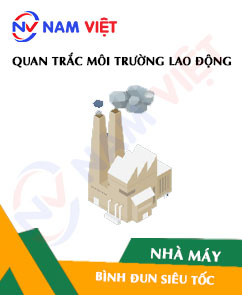
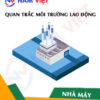
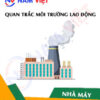
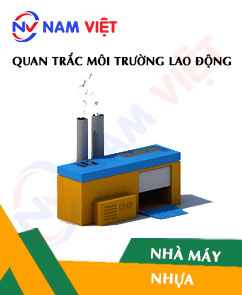


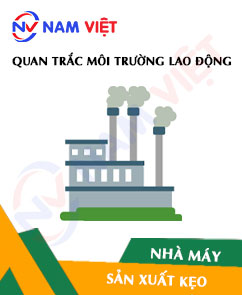

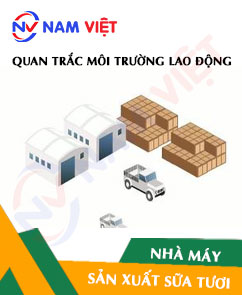


Review Occupational Environment Monitoring at Electric Kettle Manufacturing Factory
There are no reviews yet.